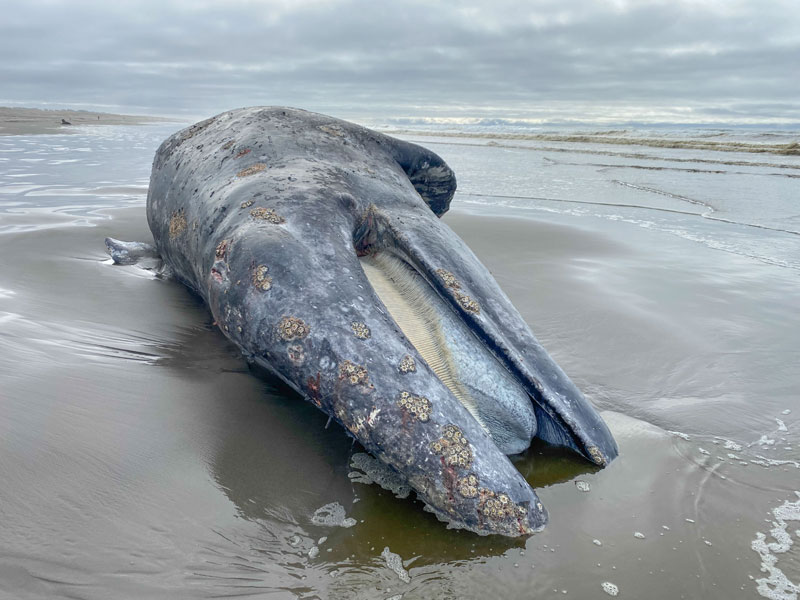Oregon Coast Crews Attend to Giant, Beached Whale on Washington Side
Published 02/19/22 at 5:06 PM PST
By Oregon Coast Beach Connection staff

Includes exclusive listings; some specials in winter
In Cannon Beach:
Includes rentals not listed anywhere else
In Manzanita, Wheeler, Rockaway Beach:
Some specials for winter
In Pacific City, Oceanside:
Some specials for winter
In Lincoln City:
Some specials for winter
In Depoe Bay, Gleneden Beach:
Some specials for winter
In Newport:
Look for some specials
In Waldport
Some specials for winter
In Yachats, Florence
Some specials for winter
Southern Oregon Coast Hotels / Lodgings
Reedsport to Brookings, places to stay; winter deals
(Ocean Park, Washington) – Crew and scientists from the Oregon coast came up to the southern Washington coast on Friday to deal with a whale that had beached there on Thursday, including conducting a necropsy. The gray whale was 39 feet long and an adult male, and it was clear it had been dead for some time before washing up. (All photos Tiffany Boothe, Seaside Aquarium)
Tiffany Boothe of Seaside Aquarium said her group came to the site on a beach at Ocean Park, as well as scientists from Portland State University and Cascadia Research Collective.
“While it can be difficult to determine the exact cause of death on larger whales, especially those which have been dead for a while before washing ashore, it was clear that this whale suffered some sort of severe trauma which was most likely due to a ship strike.”
Gray whales are currently just between their migration southward and their spring migration northward, with March being the starting point for their run up to Alaska, resulting in the peak Whale Watch Week for Oregon coast and Washington coast spectators at the end of March. Where this whale fit in is anyone's guess, but its body contained some elements of big interest to scientists: whale lice, gray whale barnacles and what's in their intestines.

Orca scars and and barnacle scars on the gray whale
Boothe said gray whale barnacles (Cryptoplepas rhachianecti) are host-specific, which means they can not be found attached to or living on any other species except Gray whales. Their life cycles are tied in closely to the migrations of the gray whale. When it's mating season, thousands head southward to the protected lagoons and bays off Mexico's coastline. In those calm, warm waters, the gray whale barnacles release their larvae. This is an exceptionally smart quirk of evolution, because it allows the larvae to more easily find hosts in smaller, more enclosed areas.
Once attached, they're riding a food train: gray whales spend a lot of time in nutrient-rich waters.
Then there's gray whale lice, which are a form of crustacean that specializes in living on whales in crevices or wounds. They are a parasite, but not a true parasite: there's some mutual benefit. The crustaceans eat dead skin off the whale, thereby helping it.
“Mothers can spread their lice to their newborn calves,” Boothe said.
Whales will sometimes breach or scrape themselves on things to get rid of the whale lice or barnacles.
One of Tiffany's photos shows the fin of the gray whale and a host of white circular marks and other scratches. The circular formations are barnacle scars – where they've come off. The straight-line gouges are from an orca attack.
Whale experts on the Oregon coast and Washington coast often use markings like these to ID whales.
Scientists also pulled out the intestines of the gray whale. The gray whale has nearly the longest intestine in the animal kingdom at near 300 feet long.
Soon begins the spring migration of whales along the Oregon coast and Washington coast, where you'll see a good portion of the 18,000 such whales living along the eastern Pacific.
Seaside Aquarium manager Keith Chandler said he isn't sure what Washington officials will do with the gray whale, but it's likely it will be left as food for local wildlife. It's in a somewhat remote stretch of beach near Oysterville, he said.
“That's a lot of eagle food,” Chandler said. MORE PHOTOS BELOW
Hotels in Astoria/Seaside - Where to eat - Astoria Maps and Virtual Tours
Cannon Beach Lodging
Nehalem Bay Lodgings
Manzanita Hotels, Lodging
Three Capes Lodging
Pacific City Hotels, Lodging
Lincoln City Lodging
Depoe Bay Lodging
Newport Lodging
Waldport Lodging
Yachats Lodging
Oregon Coast Vacation Rentals
Oregon Coast Lodging Specials


More About Oregon Coast hotels, lodging.....
More About Oregon Coast Restaurants, Dining.....
LATEST Related Oregon Coast Articles
Advisories, watches and warnings in various areas except the central Oregon coast. Weather, traffic
N. Oregon Coast Rescuers Assist Boaters with No Life Vests at Netarts Bay
N. Oregon Coast rescuers discovered boaters at Netarts Bay with no life vests. Beach safety
Oregon Coast This Week: Grisly 'Globster' Stuck in Devil's Punchbowl, Rescue ...
A whale carcass is floating around Devil's Punchbowl; an injured hiker was rescued at Bayocean. Marine sciences
Video: Notorious Bump on Route to Oregon Coast Replicates - But There's a Hum...
Recent storms have caused more landslides that lead to roadway buckling. Traffic
Ice Skating Rink at South Oregon Coast's North Bend A Big Hit and New Tradition
In downtown North Bend through January 31, 2026. Coos Bay events
This Week's Oregon / Washington Coast King Tides: What It Brings, What It Doe...
No large waves expected, but still interesting conditions in both states. Weather
Central Oregon Coast Silent Disco - and Newport Seafood Wine Fest 2026 Preview
Silent Disco at NPAC on January 10; Seafood Wine Fest runs February 19?22. Newport events
Newport Gets Rescue Copter Back After Lawsuit, Still Fighting ICE Dentention ...
The move would have left the closest helicopter rescue 100 miles away. Safety
Back to Oregon Coast
Contact Advertise on BeachConnection.net
All Content, unless otherwise attributed, copyright BeachConnection.net Unauthorized use or publication is not permitted




















































